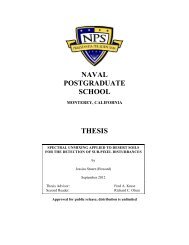October 2000 Newsletter - Naval Postgraduate School
October 2000 Newsletter - Naval Postgraduate School
October 2000 Newsletter - Naval Postgraduate School
Create successful ePaper yourself
Turn your PDF publications into a flip-book with our unique Google optimized e-Paper software.
RESEARCH CENTER<br />
RAD-HARD SEMICONDUCTOR CHIPS, continued from page 15<br />
Creation of a Center of Excellence at NPS<br />
Because of the importance of rad-hard electronics to both the defense and<br />
commercial sector the organization of a center of excellence at NPS has a unique<br />
ability and advantages in this field: a) Several faculty who research radiation<br />
effects in electronics, b) Unique radiation sources (NPS LINAC and Flash X-ray<br />
facility), 3) Graduate students cleared at the secret and top secret level, 4) Close<br />
proximity to Silicon<br />
Valley to interact with<br />
semiconductor<br />
foundry and virtual fab software firms, and 5) Close interaction with<br />
DoD personnel in R&D, acquisition, and operations that require<br />
rad-hard ICs.<br />
For several years, projects related to radiation effects have been<br />
increasing at NPS and the idea of a center has been discussed.<br />
Recently the NPS Linear Accelerator (LINAC) and the Flash X-ray<br />
facility have been revitalized. These facilities are now available for<br />
faculty to supplement research and for outside researchers needing<br />
radiation sources.<br />
The faculty at NPS has a broad range in studying radiation effects<br />
in electronics; Associate Professor Sherif Michael, Department of<br />
Electrical and Computer Engineering, has done considerable work in<br />
studying solar cells and analog electronics, Associate Professor<br />
Douglas Fouts, Department of Electrical and Computer Engineer-<br />
Electronics Technician Don Snyder in the early<br />
1970s maintaining the LINAC beamline. Thirty years<br />
later, Don Snyder was critical in revitalizing the ing, in the design and layout of rad-hard digital VLSI circuits, and<br />
LINAC after damage due to flooding in 1998. --continued on page 17<br />
HISTORY OF NPS’ LINEAR ACCELERATOR: THE “LINAC”<br />
In the early 1960s, Franz Bumiller joined the NPS faculty<br />
after several years of research at the Stanford High Energy<br />
Physics Laboratory. He wanted to build a linear accelerator<br />
at NPS that would be smaller than the Stanford accelerator.<br />
Work was started in January 1965 and a beam was obtained<br />
in 1967. NPS Physics Professors John Dyer and Fred<br />
Buskirk were involved in this early phase of the NPS<br />
LINAC.<br />
The initial construction was funded by a $250,000 grant<br />
from the Chief of <strong>Naval</strong> Research. Also much excess<br />
equipment was obtained from Stanford laboratories.<br />
Material obtained from Stanford included the accelerator<br />
beam pipes, electromagnets to handle the beam and some of<br />
the electronic instrumentation. In addition, much DoD<br />
surplus was obtained, including about 100,000 pounds of<br />
lead for radiation shielding.<br />
In simple terms, a linear accelerator works by employing<br />
microwaves to accelerate the electron beam. Faculty<br />
The members of the new Center for<br />
Radiation Hardened Effects and others<br />
at NPS would like to thank both<br />
Electronics Technician Don Synder,<br />
Department of Physics, and Professor<br />
Emeritus Fred Buskirk in providing<br />
an exceptional effort to bring the<br />
LINAC back to operation.<br />
working at Stanford on microwaves for radar during WWII<br />
had apparently visualized the possibility of accelerating<br />
electron beams.<br />
In any text on microwaves, it is noted that the TM o mode<br />
of a circular wave guide has an electric field along the guide.<br />
It is just this electric field which can be used to accelerate a<br />
change. However, it is also noted that the phase velocity of<br />
any waveguide mode is greater than c, the velocity of light.<br />
But, Einstein’s relativity theory tells us that an electron must<br />
have a velocity less than c.<br />
To resolve this problem, the uniform waveguide (as used<br />
in a radar set, for example) has loading discs installed.<br />
These discs slow down the microwaves but require very high<br />
frequency stability from the microwave source. The accelerating<br />
process may be compared to a surfboard (electron)<br />
riding in phase with an ocean wave (the microwave) and<br />
staying at a point where it always gets a forward force.<br />
--continued on page 17<br />
NPS Research page 16<br />
<strong>October</strong> <strong>2000</strong>
















